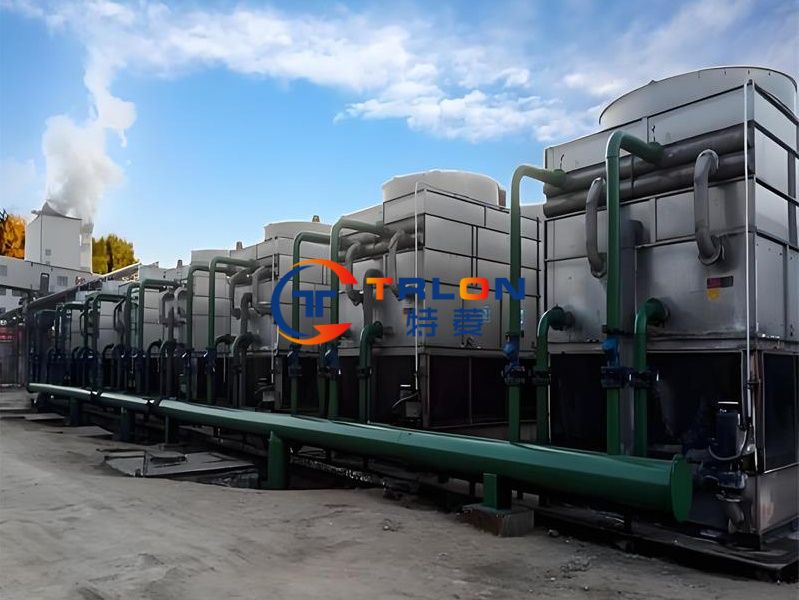
Cooling towers are divided into open cooling towers and closed cooling towers, but what is the difference between the two? Let's take a look.
1、 Operating principle
Operating principle of closed cooling tower: Closed cooling tower uses the principle of absorbing heat during water evaporation to cool the cooled liquid. Spray water (cooling water) is stored at the bottom of the cooling tower, and the working fluid (softened water or other liquid) circulates in a closed cooling tower cooling coil. Spray water is distributed by a spray pump system and nozzles on the surface of the coil, and some water evaporates, absorbing heat and reducing the temperature of the working fluid in the pipeline. The water in the hot air and the unevaporated water are intercepted by the water blocking plate and flow through the polyvinyl chloride heat exchange layer. The water in the polyvinyl chloride heat exchange layer is cooled by the flowing air, the temperature decreases, and it falls into the chassis. It is circulated from the water pump to the water distribution system, and then poured into the coil for circulating cooling.
The operating principle of an open cooling tower: An open cooling tower is a type of tower that sprays hot water into water droplets or water films, causing water to flow from top to bottom and air to flow from bottom to top or horizontally. It utilizes the heat generated by water evaporation and the heat transfer of cold air and hot water through the water; According to the direction of water and air flow. According to the direction of water flow and air flow, it can be divided into cross flow and counter flow cooling towers.
2、 Performance
1. Water consumption: From the perspective of a single cooling tower, compared to a closed cooling tower, an open cooling tower with the same cooling capacity has higher circulating water loss during operation, while a closed cooling tower consumes almost no circulating water during operation.
2. Power consumption: Due to the distinction between internal and external circulation in closed cooling towers, closed cooling towers with the same cooling capacity run more pumps than open cooling towers, resulting in a relative increase in power consumption.
3. System maintenance: The circulating water of the enclosed cooling tower operates in a closed loop, without external impurities mixing or algae growth. The cooling equipment is not affected by scaling and algal growth, and the system maintenance is simple and the cycle is long. The circulating water of an open cooling tower operates in an open loop and comes into contact with the outside world. External impurities mix into the circulating water, making it susceptible to pollution and hardening of the water quality. This can lead to scaling and algae growth, affecting the operation of the cooling equipment. The cooling tower requires regular descaling and algae maintenance, with a short maintenance cycle.
4. Sewage discharge: The water collection of closed cooling towers is not easily exposed to direct sunlight and does not easily produce algae. The sewage discharge cycle is long, while open cooling towers are exposed to the outside world for a long time and are prone to algae and salt crystals due to direct sunlight. Regular sewage treatment is required, and the sewage discharge cycle is short.
5. Service life: The body of the closed cooling tower is made of metal plates, which have undergone anti-corrosion treatment and have a longer service life. The tower body of an open cooling tower is made of FRP, which is prone to aging and has a relatively short service life.
3、 In terms of cost
Under the same cooling capacity and operating conditions, the cost of a closed cooling tower is 2-3 times that of an open cooling tower. Users have high initial investment and low maintenance costs in the later stage. Compared with closed cooling towers, open cooling towers have lower costs, lower initial investment costs for users, and higher maintenance costs in the later stage. (Closed towers have corresponding recycling value after a few years, while open towers have almost no value)
In summary, closed cooling towers have a long service life, low circulating water loss, high cost, and provide certain protection for user equipment; Open cooling towers have a short service life, high circulating water loss, and low cost. It is recommended that users consult with professional technical personnel from cooling tower manufacturers.
Article Address:https://www.trlen.com/baike/699.html
Guangdong Trlon Energy-saving Air Conditioning Equipment Co., Ltd.
Contact:Mr. Wang
Free Hotline:4008-8383-95
Company Email:sales@trlon.com
Web Site:https://www.trlen.com/
Company Address: 1916A, Block A, David Donglong Business Building, Longhua, Longhua District, Shenzhen